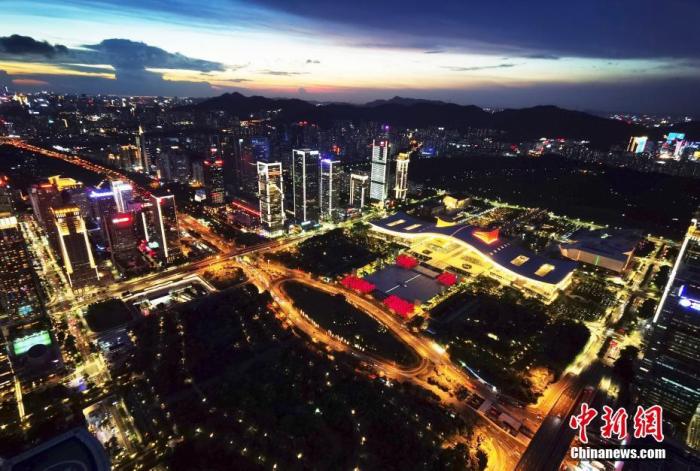(Special Economic Zone for 40 Years) Set off again in a year without confusion: The new mission of China's special economic zones is expected
China News Service, Beijing, August 26 (Reporter Li Xiaoyu) On August 26, 2020, China's special economic zones have entered the "year of no confusion".
In the past 40 years, the special economic zone represented by Shenzhen has been the pioneer of China's reform and opening up. Forty years have passed, China has changed, and the world has also changed. In an interview with a reporter from China News Agency, scholars here believed that the SAR needs to be "reborn" under the new situation.
The picture shows the night view of Shenzhen Civic Center. China News Agency reporter Chen Wenshe
Zhang Yansheng, chief researcher of the China International Economic Exchange Center, said that the special economic zone is the product of China's reform and opening up in the past 40 years. Its core task is to explore new paths for China to shift from a planned economic system to a market economic system and develop a modern economy. And as China's economic aggregate rises to the second largest in the world, and the new open economy system is gradually improving, China's requirements for special economic zones are "completely different."
For example, according to the plan, Shenzhen will be built 15 years ahead of the entire country to create a visible, tangible, and replicable city "sample" of a modern and powerful socialist country; Hainan will become China's "open economy new model" by 2035. "Highland", by the middle of this century, a high-level free trade port with international influence will be fully established. This is undoubtedly a very high standard and also a considerable challenge.
At the same time, the external environment facing the special economic zone has also changed. Economic globalization has encountered a "back wave" and geopolitical risks have risen. This kind of major change unseen in a century has brought severe challenges to the special economic zones.
"Compared with the past, the task of China's reform and opening up today is not easier, but heavier; not simpler, but more complicated," said Qu Jian, vice president of China (Shenzhen) Comprehensive Development Research Institute. The arduous task of reform and opening up and the more severe and complex international environment require bolder promotion of the development of special economic zones.
When the internal conditions and external environment are undergoing profound changes, how do the special economic zones respond to the new situation? How to find a new power point?
In Zhang Yansheng’s view, in the future, special economic zones should act as “vanguards” for China in the following aspects: promoting scientific and technological innovation; realizing the modernization of the rule of law and rule governance; improving the level of the industrial chain and strengthening the docking with global industries; building the highest level of global openness "Special area"; to create a distribution center for global logistics hubs.
"The requirements for scientific and technological innovation in the next 30 years are completely different from the past. In the past, it was enough to form a complete industrial chain, but in the future, we need to create a first-class enterprise, a first-class development platform, so as to gain the initiative in international competition. Zhang Yansheng said that under this circumstance, the special economic zone should have "reinvented changes." It is necessary to make efforts to promote institutional reforms, create a good innovation ecology, and improve cross-border innovation networks to create an open, inclusive, and shared The environment that attracts the "world brain" to be used by China.
Many special economic zones have already started operations.
At present, Shenzhen is accelerating the implementation of a batch of checklists such as comprehensive authorization reform, adjustment of administrative regulations, and pilot policies, focusing on key areas such as marketization of factors and optimization of the business environment. In addition, Shenzhen is also accelerating the construction of a world-class business environment reform and innovation experimental zone, and is actively carrying out comprehensive reforms in international talent management.
Zhuhai recently announced the "2020 National Economic and Social Development Plan", preparing to give full play to the role of innovative platforms such as the Hengqin Advanced Intelligent Computing Center to attract and gather a group of science and technology projects and talent teams. At the same time, Zhuhai will also explore deepening reforms and opening up in trade and other fields, and create a business environment that is highly integrated with international rules.
Scholars here said that while the special economic zone will do a good job in its own construction in the future, it should also cooperate with other functional zones such as the pilot free trade zone.
Zhang Jianping, director of the Regional Economic Cooperation Research Center of the Institute of International Trade and Economic Cooperation of the Ministry of Commerce of China, said that the special economic zone should organically integrate its own unique functions with the functional design and positioning of the pilot free trade zone, and participate in the process of regional economic integration. New growth poles, innovation poles, and radiation poles, especially in terms of institutional openness, should lead the country.
Yu Miaojie, deputy dean of the National Development Research Institute of Peking University, suggested that the next step of the development of the special economic zone can be considered "two steps". For example, a batch of early harvest results will be formed around 2025, and a higher level of open platform will be created to enhance regional competitiveness and creativity. ; Around 2035, it will form a unified system integration with other functional areas such as the Shanghai Free Trade Zone, not only for trade and investment, but also for more in-depth expansion in management, rulemaking, legal system, taxation, and risk prevention and control.
After a good year, the more scientific and healthy development of special economic zones is worth looking forward to. (Finish)

